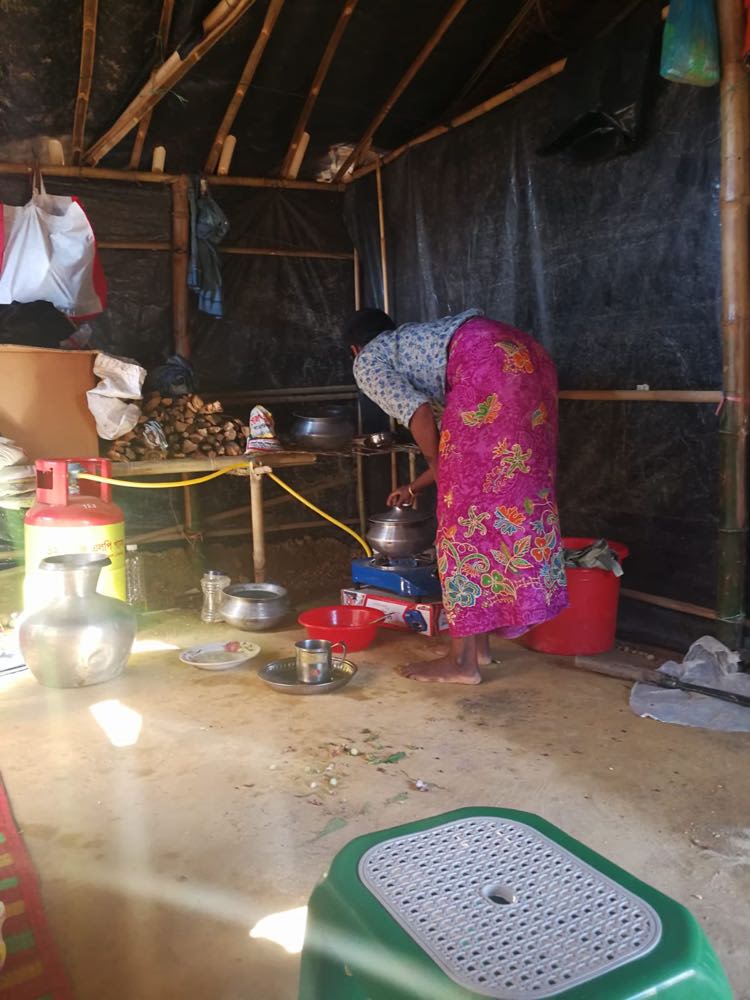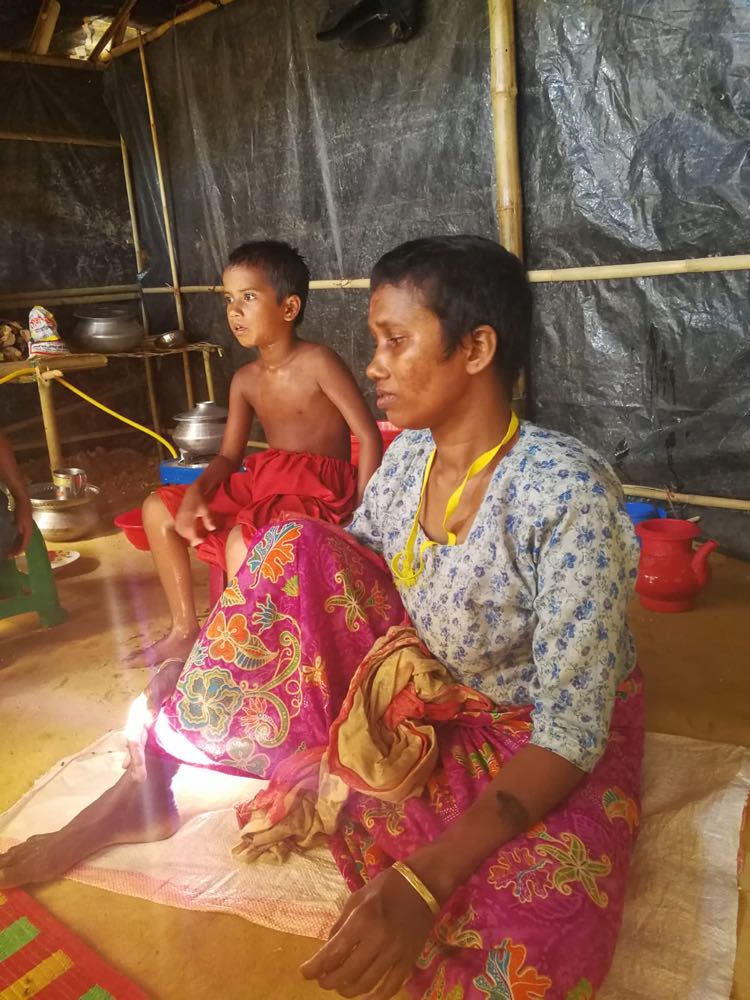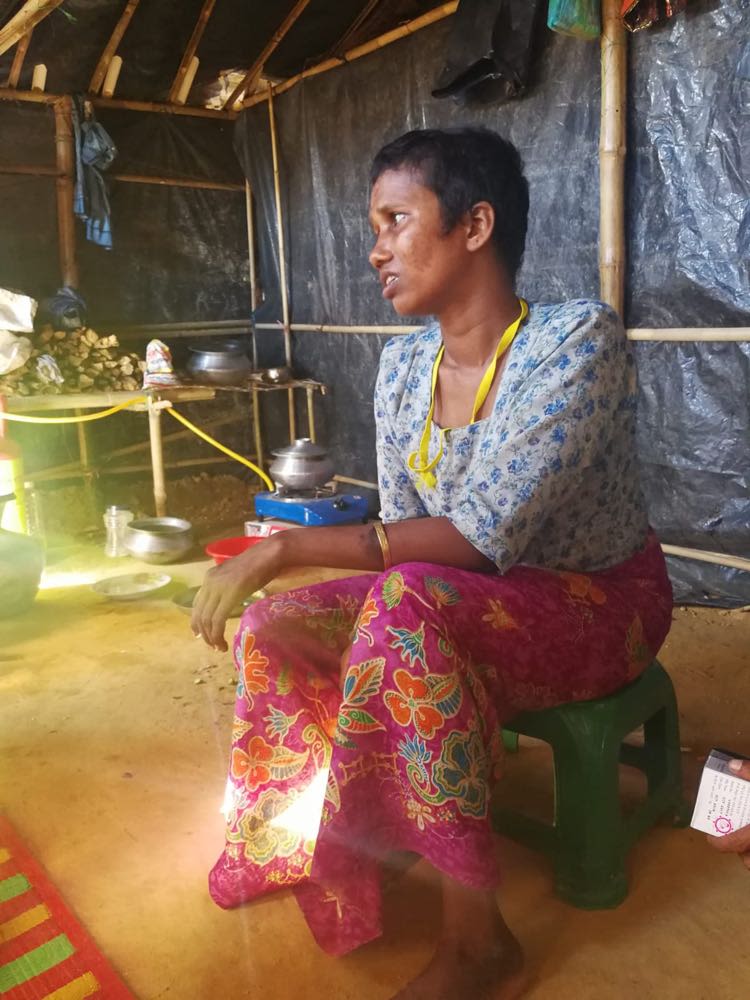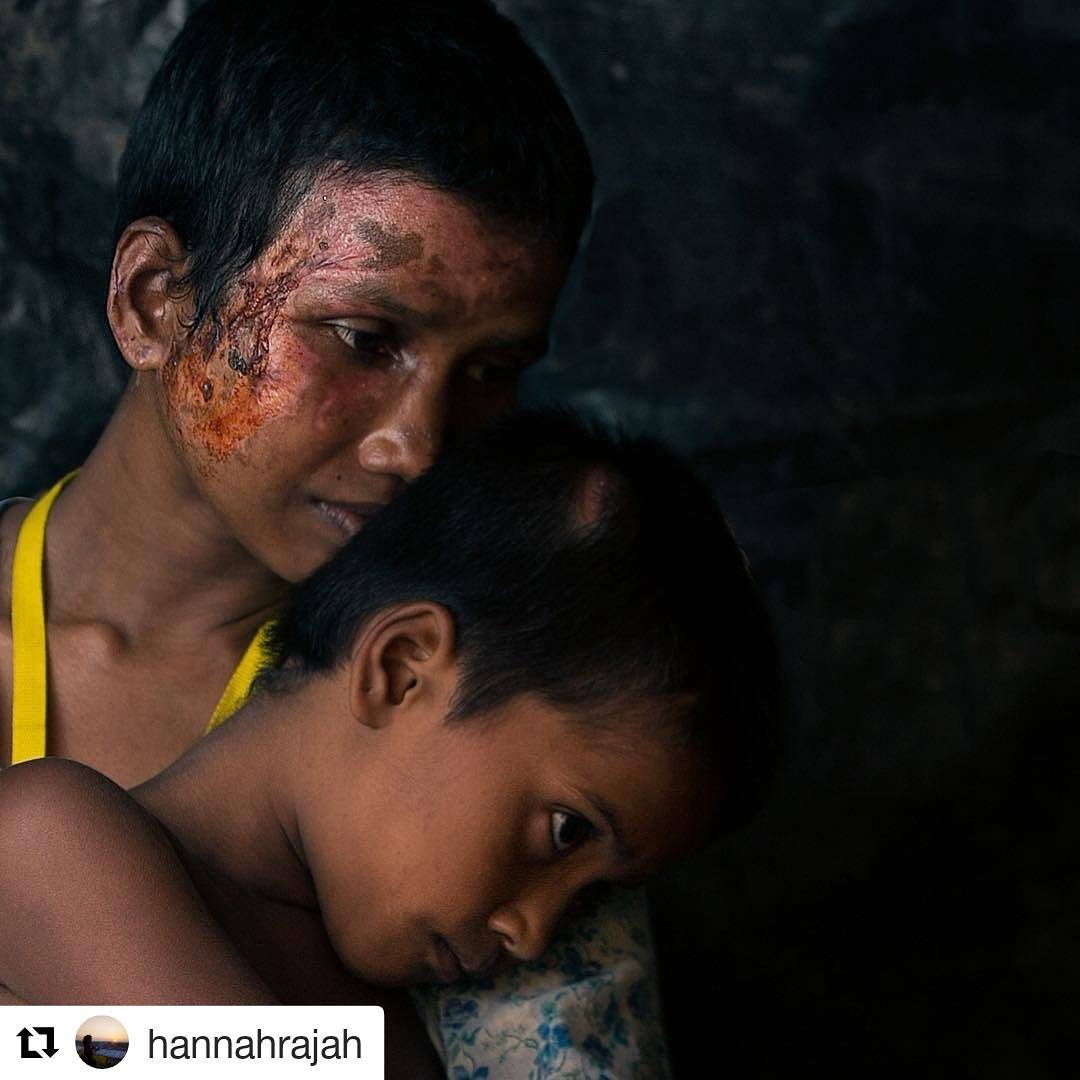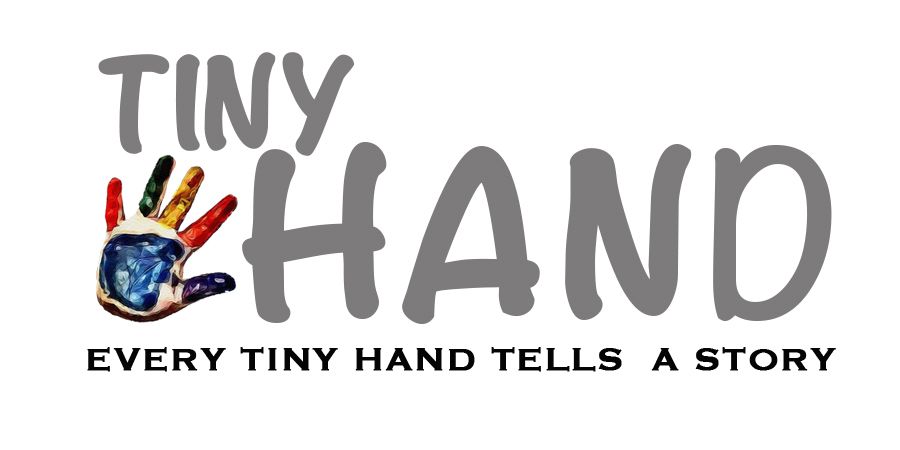Back from Death
Mother, Daughter Survive the Rohingya Massacre
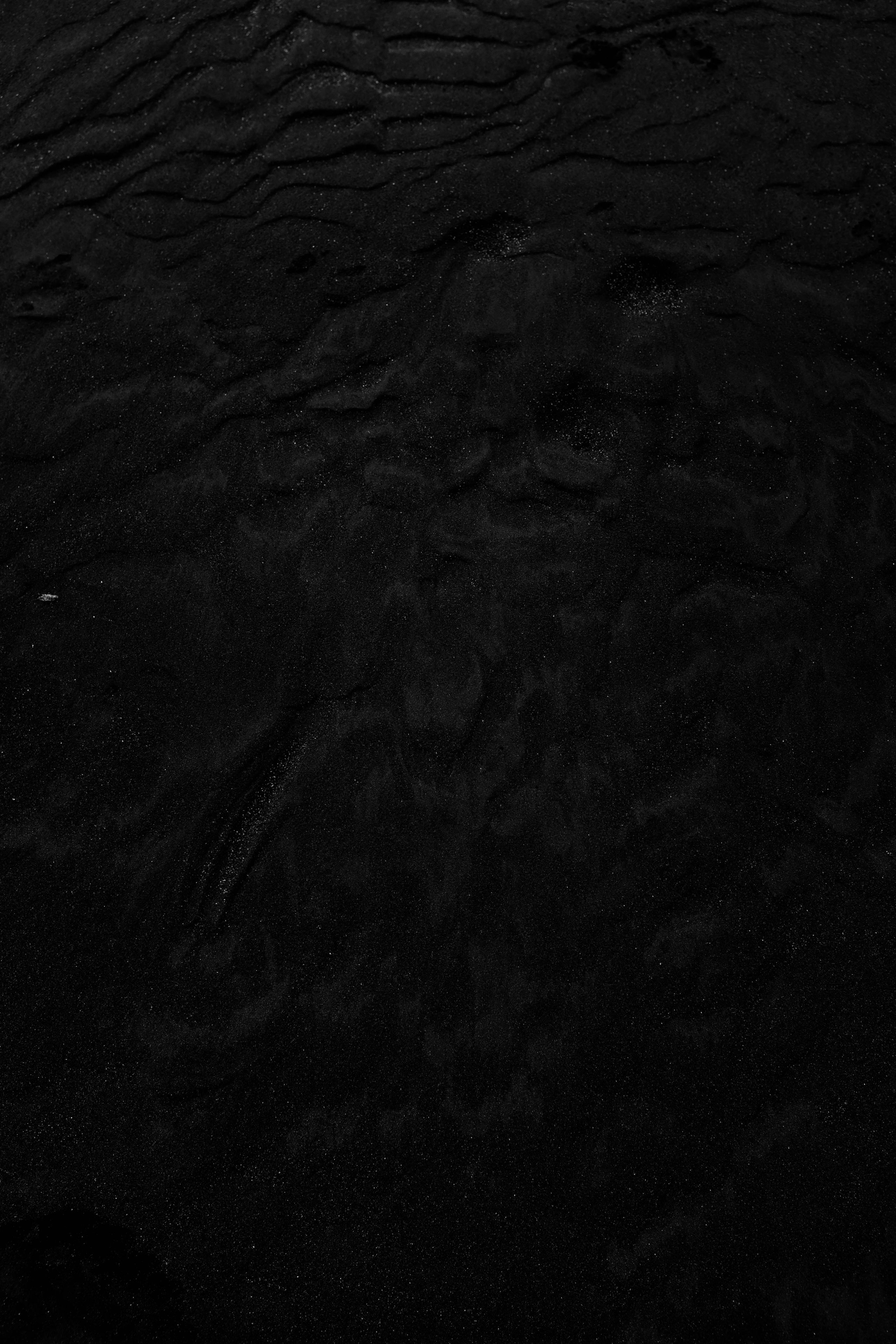
A simple, yet happy, family
Before August 30, 2017
This is Mumtaz. She is a housewife and mother of four children, of whom Razia is the only girl. Mumtaz’s husband was a farmer and woodchopper in Tula Toli, the village they used to live in and one of the Muslim Rohingya minority villages in Myanmar.
Before recounting that beautiful part of her life, Mumtaz faced us with her left cheek. It seemed there was something wrong with her right cheek that she was trying to hide. Probably! We did not press her by asking about the reason, for she had promised us to disclose everything later.
So, it was a family of six. The parents had pledged to dedicate their life and income to improve their children’s life and secure a good future for them. In fact, children had always been given priority.
In their village, life was no different from that of villagers in nearby villages. They lived in bamboo cottages with straw roofs, surrounded by paddy fields and huge trees from all directions.
Not far from Mumtaz’s cottage, Naf River flows fast, marking the border of southeastern Bangladesh and western Myanmar. It is there where children would find a place to play. They would build sand castles and houses. Yet, they preferred not to swim in the river to avoid being drifted away along by its water currents.
While together, they would exchange stories about their Rohingya ancestors who eventually drowned in that river. Over the past twenty years, this river had witnessed incidents, displacement, and conflicts which put an end to the lives of many Rohingya people.
However, they did not dread the river, for they would build a ship one day. That was one of Mumtaz children’s dream. They would build a ship to roam the world, without being asked by anyone about their nationality or passports. In fact, their country’s government had deprived them of their nationality deeming the Rohingya people as illegal immigrants from Bangladesh.
Yet, Mumtaz’s children did not imagine that their next residence would be 6 kilometers far from the river, at Cox’s Bazar Camp in Bangladesh. In better words, it would be their sister Razia’s new abode. It was to become her new dwelling without her three brothers, though.
At the Village: On the Massacre Day
August 30, 2017
The night of August 29 was long and intolerably humid. Unlike August’s rainy days, the sky did not shed a single raindrop during that very day. In spite of her feeling uneasy because of the heat, Mumtaz was to realize later that the soil’s dryness would save the lives of many!
That night, rumors spread in the village that 90 soldiers of Myanmar Army had arrived and besieged the village, after torching some neighboring villages.
It seemed that incidents similar to those took place in October, 2016, were about to happen again, when some armed Rohingya people attacked police stations, killing some soldiers, was followed by the mobilization of the entire Myanmar Army to wreak vengeance on the Rohingya villages.
On that Wednesday morning, August 30, 2017, “all the lights went out and my world turned black,” said Mumtaz.
The army did not only attack her village. It also attacked her life’s minutest details, the place where her children learnt to walk, the tree they sat down by when her child first uttered the word, “Mama,” her neighbors’ cheerful faces, and her husband’s echo as he called from afar, attracting his children’s attention that he had come back after a long work day.
On that morning, after setting the Rohingya cottages on fire, they were dragged to the river bay. “I cannot describe the fear we felt then,” Mumtaz related, “I was holding my four children when they separated me from my husband.”
Male villagers were gathered, and forced to stand side by side.
Whoever tried to flee was shot dead; whoever managed to flee drowned in the river. However, the group that managed to flee toward the hills survived after walking for days to all the way toBangladesh.
But Mumtaz’s husband was not among them.
They had killed him before the eyes of his wife and children. “They chopped off men’s heads, before they shot them and put their bodies in mass graves. Those graves were later set on fire to burn the corpses,” she continued.
That was not the end of it, Mumtaz added. “I was holding my children, with my heart stricken with grief for my husband and neighbors,” she said, “I had not realized what happened except when an army soldier approached and took two of my children away.”
Mumtaz gazed at us with a look that can be seen on the faces of all of Cox’s Bazar residents; the camp where all survivors of the genocide settled down. And that is a look so sad and full of wrath!
“They chopped off their heads. They were two lovely children who kept crying out for help,” she said, “I will never forget the panic in their eyes and on their faces.”
Amidst sadness, agony, and strong smell of death mixed with the smoke of the burning houses, Mumtaz held the hands of Razia and her last child. She tried to contain herself to escape an inevitable death.
But she could not make it.
Her son, who was only eleven, was beaten and shot dead. He was thrown into the mass grave. “Yes, all my family members were in that grave.”
It is not just Mumtaz’s family that was killed in that massacre. More than 6700 Rohingya people, among whom no less than 730 children under the age of five, were killed along, according to Doctors Without Borders (MSF).
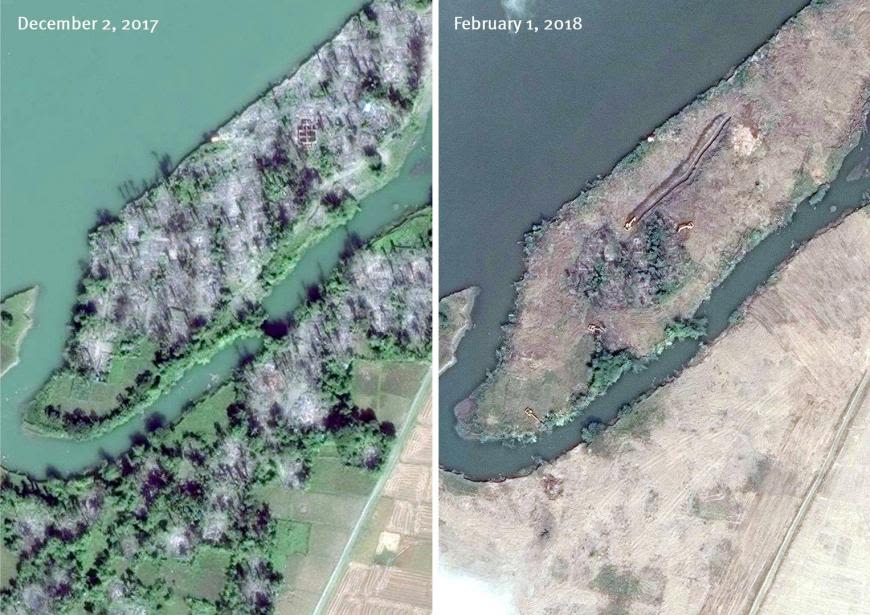
Satellite imagery recorded before and after the clearing of the destroyed village of Myar Zin. © 2018 DigitalGlobe
Satellite imagery recorded before and after the clearing of the destroyed village of Myar Zin. © 2018 DigitalGlobe
At the Village: Between Life and Death
There was no time for weeping or surrendering. We shall put off grief until we save our lives" — Thus Mumtaz made her decision as she looked at her scared little girl whose hands were shaking despite the hot weather of about 30 C°.
The army started dividing the female villagers into groups of 5 women each. Accompanied by her mother and daughter, Mumtaz’s group was led by 10 army members to one of the village cottages.
“They collectively raped and beat us violently. They wounded me in the stomach and cut off my mother’s neck,” said Mumtaz, “I used to hear my child scream that they might stop beating her in vain.”
Before leaving that house, the soldiers spilled kerosene everywhere and on women’s bodies and ignited them with a match. “Fire blazed everywhere; and my world was turned into complete darkness.”
Mumtaz passed out for a while, and Razia kept screaming and calling her to wake up: “Please wake up, mom! We’re in danger. We have to leave this place.”
Razia, the seven-year-old girl, saved her mother. She broke one of the bamboo cottage walls and both fled.
“We were the only two survivors,” said Mumtaz.
Razia’s naked body was burning. She led her mother to a secret place. They drank water and cooled their wounds and burns. Then, they fled to the forest. “I was very tired and needed sleep.” This is the whole story. The mother and her child dozed beside a tree trunk.
“I do not know for how long we slept; it might be minutes or even hours. But that was not important, for at those moments, I realized time was not important after what had become of us. Today, I am a soulless body.”
The mother was awakened by some villagers’ voices, telling them they had to leave the place. They made a handbarrow of cloth and bamboo twigs. They put Mumtaz and Razia on it and headed toward a boat near the forest.
“We rode the boat and headed towards Bangladesh. I had feelings that I died too to follow and join my husband and three children,” said Mumtaz.
No sooner had the boat reached Bangladesh, than Razia started to beg for money so she might take her mother to hospital. From thence, they were transferred to Cox’s Bazar Camp, the world’slargest refugee camp, with half of its residents are children
"Let the world see my burnt body! These are the Rohingya mothers’ bodies and our burnt hearts!"
Razia was patting her mother’s short hair to appease her agony, while Mumtaz was recountingher cruel heartbreaking journey that brought her to this small bamboo-made shelter covered with black waterproof plastic, at Cox’s Bazar Camp.
It was stuffy inside with a temporary lavatory in one corner. In another, Razia had placed a kettle. “She cooks rice for us to eat,” said Mumtaz, “My heart breaks whenever I look at her. This brave little girl has matured quickly.”
Before we left, and as she promised, Mumtaz turned her face so we might see her right cheek. It was scorched and deformed from head to neck. She told us that her entire body had similar burns.
“Let the world see my scorched body, for there are thousands of women who went through the same experience; but nobody knows about them,” she added.
“Every day, when I see the children in the camp, I remember my own children. I miss them so much. They were my life. I also miss my husband. I feel I am going crazy,” she continued, “I do not know what is going on. I demand justice for my husband, family, and nation. I live to demand justice. I am here for my daughter.”
A Village that Turned into Ashes
No less than 288 villages in the northern state of Rakhine after August, 2017. Among those villages was Mumtaz’s, as reported by Human Rights Watch’s analysis of satellite images.
The massacre also resulted in killing around 6,700 persons, with no less than 730 children under the age of five, says Doctors without Borders’ (MSF) estimates
Interviewer: Aysha Al Sharbati
Razia and Mumtaz
